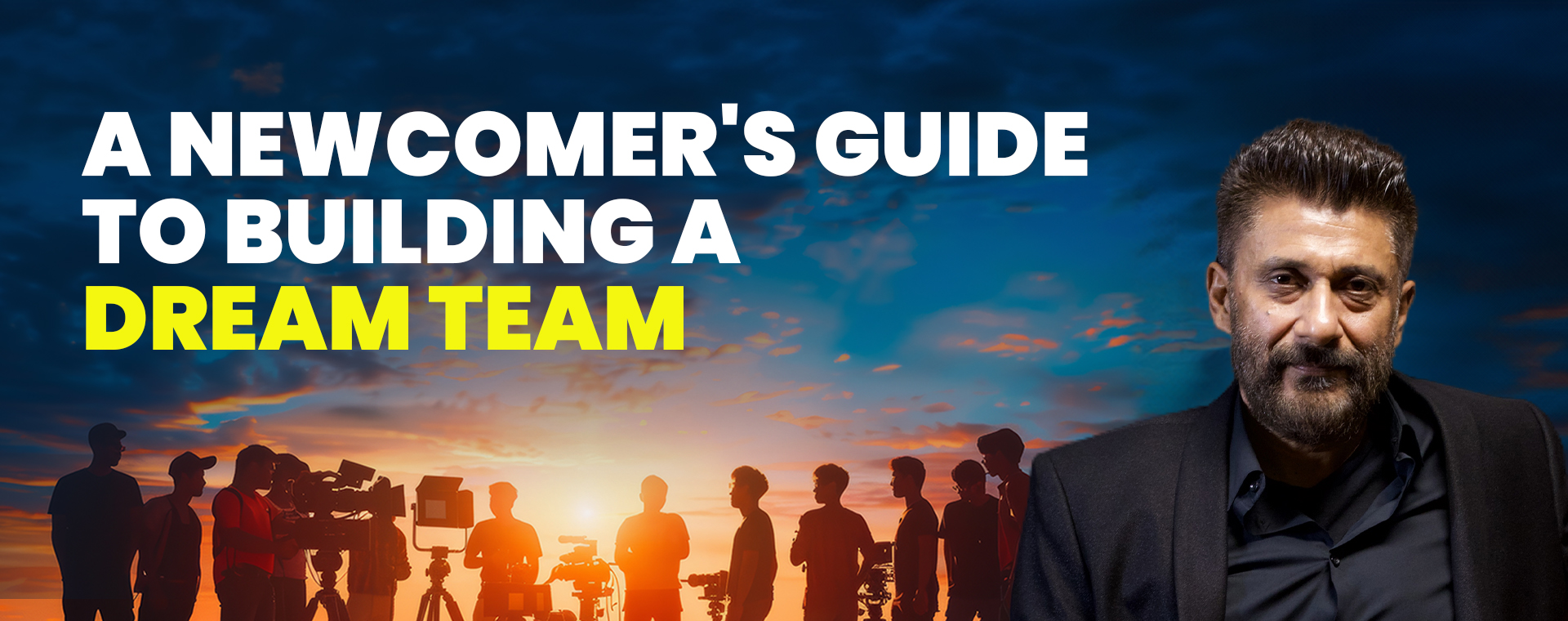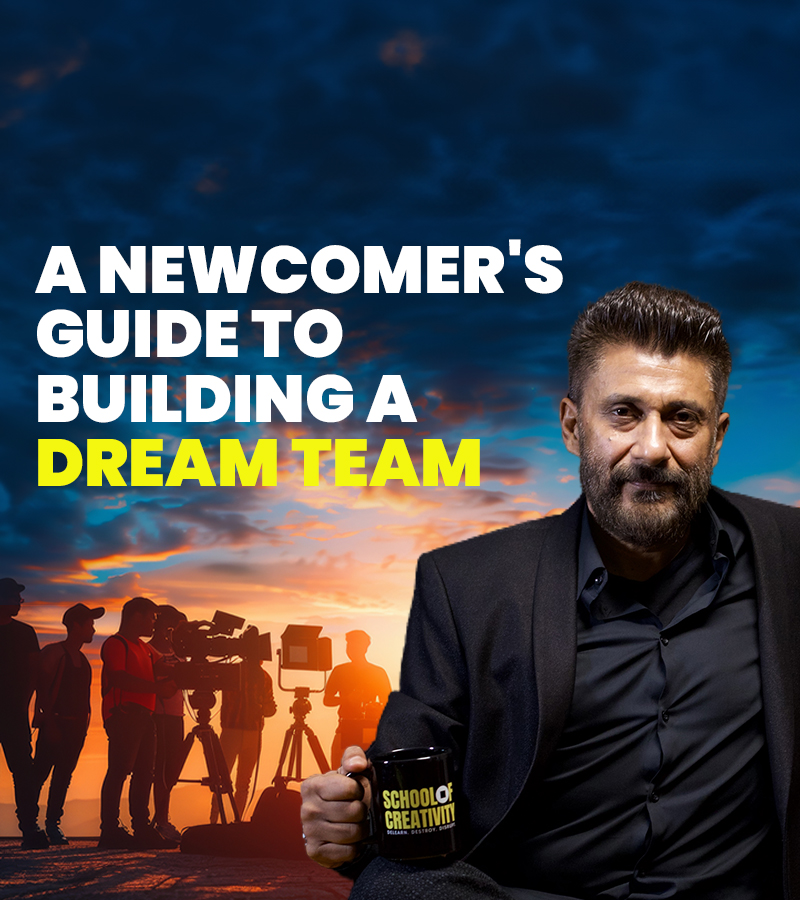

Building Your Dream Team: A Beginner’s Guide to Filmmaking
Dive into the collaborative spirit of filmmaking with guidance on building the perfect team, embracing digital tools for seamless collaboration, and nurturing a creative and supportive environment for every project.
Creating a film is an exhilarating journey, a blend of art, storytelling, and technical mastery. Every individual involved plays a pivotal role, akin to musicians in an orchestra, each contributing their unique note to the harmony. Drawing on Vivek Ranjan Agnihotri’s philosophy of collaborative creativity, let’s explore how to assemble a team that brings your cinematic vision to life, ensuring the process is productive and fulfilling.
The Core Team
Director: The director is the visionary, translating the written script into a visual masterpiece. Finding a director who aligns with your vision is crucial. This person should not only share your passion but also possess the ability to guide the team through creative challenges, making decisive choices that enhance the story.
Producer: Think of the producer as the project manager of your film. They’re responsible for the logistical side, from budgeting to scheduling. A great producer can balance creative desires with practical limitations, ensuring the project stays on track without compromising the artistic vision.
Screenwriter: The script is the foundation of your film. A screenwriter crafts the dialogue, characters, and narrative flow. Choose someone who is not only talented in storytelling but also adaptable and able to refine the script based on collaborative feedback and the project’s evolving needs.
Director of Photography (DoP): Your DoP is your artistic eye, responsible for capturing your vision on camera. Their expertise in lighting, shot composition, and camera movement is vital. The right DoP will understand the mood and style you’re aiming for and bring it to life visually.
Enhancing Creativity
Production Designer: This role is about creating the film’s visual world. From the locations to the sets to the smallest props, the production designer works to make the script visually tangible. Look for someone inventive who can creatively interpret the story’s setting and characters within your budget constraints.
Music Composer and Sound Designer: Audio enriches the visual experience, conveying emotions and enhancing the narrative. Composers and sound designers should have a keen understanding of how music and sound play into the film’s overall mood, creating an auditory landscape that complements the visual one.
Editor: The editor is where your story finds its rhythm. They construct the narrative pace and flow through careful selection and sequencing of shots. An editor with a strong sense of narrative can dramatically impact your film’s effectiveness, making key decisions that keep the audience engaged from start to finish.
For a masterclass on creativity and filmmaking, sign up here now: ttps://vivekagnihotri.com/school-of-creativity>
Building Support
Casting Director: The right cast can elevate your film, bringing depth and authenticity to your characters. A casting director with a good network and an eye for talent is essential. They understand the nuances of performance and can help you find actors who embody the characters you’ve envisioned.
Costume and Makeup Artists: These artists add layers of meaning and context to your characters, visually representing their personalities, histories, and circumstances. Their work is crucial in immersing the audience in the film’s world, requiring both creativity and an acute attention to detail.
Technical Crew: Your technical crew is the backbone of your production. It handles everything from lighting to sound recording. Experienced, reliable, and passionate crew members ensure that the practical aspects of filmmaking are executed flawlessly, allowing the creative elements to shine.
Fostering Team Dynamics
Communication and Flexibility: Open lines of communication foster a creative and collaborative environment. Encourage your team to share ideas and be flexible. Creative solutions often come from unexpected places, and a willingness to adapt can lead to breakthrough moments.
Respect and Trust: Mutual respect among team members creates a positive working atmosphere. Trust in their expertise and give them space to contribute creatively. This trust builds a strong, cohesive team ready to tackle any challenge.
Celebrating Milestones: Acknowledge the hard work and achievements along the way. Celebrating progress, big or small, boosts morale and reinforces the team’s commitment to the project.
Leveraging Technology for Seamless Collaboration
Harnessing Digital Tools: In today’s digital age, leveraging technology can streamline the filmmaking process and enhance collaboration. Utilize project management apps like Trello or Asana to assign tasks, track progress, and set deadlines. Cloud storage services such as Google Drive or Dropbox can facilitate easy sharing of scripts, storyboards, and footage, ensuring everyone on the team can access the latest versions.
Virtual Meetings and Workshops: Given the diverse locations of team members, virtual meetings via platforms like Zoom or Google Meet become indispensable. They offer a space for brainstorming, progress updates, and resolving creative differences in real time. Consider organizing virtual workshops for script readings, performance rehearsals, or technical run-throughs, fostering a sense of unity and shared purpose among the team.
Nurturing Creativity and Well-being
Creating a Supportive Environment: Film production can be emotionally and physically demanding. It is crucial to create a supportive environment where team members feel valued and heard. Encourage open dialogue about stress and workload and be willing to make adjustments to ensure well-being.
Encouraging Creative Exploration: Allocate time for team members to explore creative ideas that may be outside the immediate scope of the project. This could mean experimenting with different cinematography techniques, exploring side stories with characters, or improvising dialogue. Such exploration can lead to unexpected discoveries that enrich the film.
Well-being Initiatives: Incorporate well-being initiatives into the production schedule. This might include mindfulness sessions to reduce stress, team-building activities to strengthen bonds, or scheduled downtime to recharge creatively. A team that feels well taken care of will perform at their best, bringing passion and energy to the project.
Conclusion
Assembling a dream team for your film is about more than just gathering talent; it’s about creating a community united by a shared vision. Inspired by Vivek Ranjan Agnihotri’s collaborative spirit, remember that each team member brings something unique. By fostering an environment of open communication, respect, and creativity, you’re not just making a film but embarking on a memorable journey with a group of passionate individuals. Together, you’ll navigate the challenges and triumphs of filmmaking, turning your shared vision into a cinematic reality that resonates with audiences far and wide.






